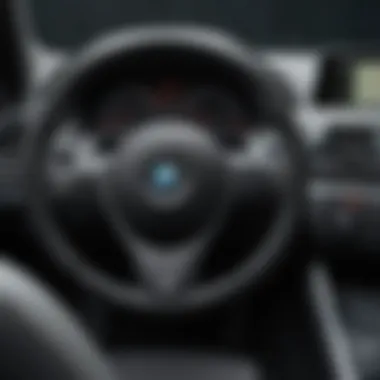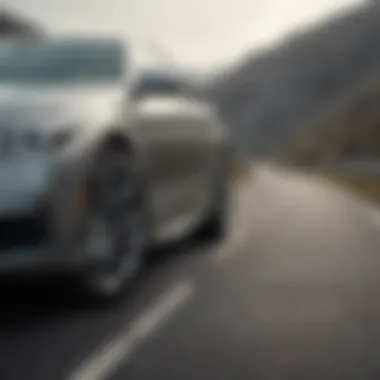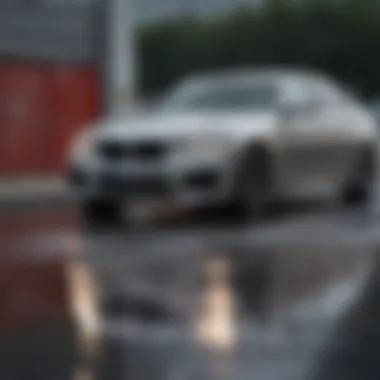Exploring the 2013 BMW Hybrid: Performance and Market Impact


Intro
The 2013 BMW Hybrid stands as a benchmark in the evolution of modern vehicles, offering insights into both performance and technological advancements. Designed to merge BMW's luxurious reputation with the benefits of hybrid technology, this vehicle creates a unique proposition for automotive enthusiasts and conscientious buyers alike.
With its entry into the hybrid market, BMW embraced an increased focus on sustainability. The brand aimed not just to satisfy performance expectations, but also to meet environmental goals without compromising luxury. In the following sections, we will delve into the specifics of this hybrid model, assessing its performance, design, technology, and eventual market reception.
Car Reviews
Overview of the Vehicle
The 2013 BMW Hybrid encapsulates innovative features that appeal to various types of drivers. This car highlights BMW's proficiency in crafting vehicles that provide both style and substance. Engineered with meticulous attention, it boasts hybrid capabilities alongside powerful performance. Drivers can expect excellent responsiveness on the road, combined with noteworthy fuel efficiency.
Performance Analysis
Performance is a crucial differentiator for the 2013 BMW Hybrid. Equipped with a 3.0-liter inline-six engine along with an electric motor, it generates a total output nearing 335 horsepower. The acceleration from zero to sixty mph is impressive for a hybrid, taking approximately 5.7 seconds. Furthermore, the engineering advancements in this model reflect a commitment to driver-experience without compromising its role as an eco-friendly vehicle. Recent data shows that many hybrid models are optimized for city driving, confirming this hybrid aligns well with urban needs.
Design and Interior Features
Aesthetically, the 2013 BMW Hybrid embraces a sleek design synonymous with the BMW brand. The exterior features classic BMW curves, evoking a sense of luxury and position in the market. Inside, the cabin showcases premium upholstery, intuitive controls, and spacious configurations. Features like a navigation system, high-quality audio, and comfortable seating reiterate the vehicle’s focus on luxury.
Safety Ratings and Specifications
Safety is another paramount aspect of the 2013 BMW Hybrid. This hybrid comes equipped with several airbag systems, advanced traction control, and anti-lock brakes. Testing and reviews have frequently praised its stopping distance and stability under different driving conditions. Thus, safety professionals and reviewers regard this vehicle favorably compared to other hybrids.
Value for Money
When assessing hybrid vehicles from 2013, the pricing approach taken regards the essential balance between features and performance. Buyers of the 2013 BMW Hybrid experience a luxury brand advantage while containing running costs through fuel efficiency. It can appeal to buyers not only for status set by the brand but also for the practicality and durability brought forth with the hybrid configuration.
Automotive Industry Trends
Understanding automotive trends yields a fuller picture as we investigate the BMW hybrid’s impact over time.
Emerging Technologies
As the automotive industry shifted over the years, technologies related to hybrids began emerging more prominently. Companies are focusing on improved battery technologies, producing electric motors with higher efficiency than before.
Changes in Consumer Preferences
Consumer preferences, particularly from 2013 onwards, indicated a stronger inclination towards eco-conscious vehicles. Preferences affect manufacturers to produce models that cater to both luxury and hybrid integrations, allowing brands like BMW to formulate choice outlines for buyers. This reflects in gradual shifts where luxury does intersect with more ecologically responsible options.
Sustainability and Eco-Friendly Practices
Sustainability now connects closely with corporate philosophies in car production. ECO driving experiences grow alongside corporate commitments to environmental initiatives. Every manufacture’s dedication to the sustainability greets consumer skepticism, making model choices crucial for a brighter environment.
“By creating hybrid vehicles like the 2013 BMW Hybrid, manufacturers are essential in shaping consumer attitudes towards sustainability in luxury vehicles.”
Future of Electric Vehicles
As the industry continues to advance, predictions lean towards electric vehicles becoming more commonplace, perhaps leading hybrids to become footnotes of a past age. Automakers are positioning electric vehicles not only for utility but also for luxurious experiences.
Industry Challenges and Solutions
Even with growth, challenges abound. From technological leaps to supply chain disruptions, factors affecting production are layered within market conditions and fluctuating demand. Automakers propose various solutions, including collaboration across sectors.
In summary, while the 2013 BMW Hybrid set distinctive trends, it is facilitating a shift in both technology and consumer awareness within the automotive sector. The forthcoming sections shall elaborate on highlighg intricacies and nuances further, amplifying understanding among both enthusiasts and future buyers.


Foreword to the BMW Hybrid
The introduction of hybrid vehicles has marked a notable shift in the automotive industry. This section provides critical insights into the 2013 BMW Hybrid, which serves as a relevant case study of designs that aspire to integrate advanced hybrid technology with traditions of automotive performance and luxury. As environmental awareness grows, car manufacturers have invested significantly in these technologies to meet changing consumer needs and regulatory requirements.
Contextualizing Hybrid Vehicles
Hybrid vehicles operate on the synergy of two power sources, typically a gasoline engine coupled with an electric motor. This combination seeks to improve fuel efficiency and reduce emissions. The demand for hybrids stems from increasing fuel costs and concerns about climate change, guiding consumers towards solutions that minimize their environmental impact while maintaining functionality and comfort.
The hybrid vehicle landscape is diverse, incorporating various models to cater to distinct consumer preferences ranging from economic commuter cars to luxurious options. By blending traditional performance capabilities with ecological benefits, hybrid cars appeal to a broader audience. They signify innovation, advancement, and the willingness of manufacturers to evolve with shifting market demands.
Overview of BMW's Hybrid Strategy
BMW, known for its engineering excellence and commitment to driving pleasure, was immediately recognizing the necessity for hybrid models in its lineup. The launch of the 2013 BMW Hybrid complemented the company's strategy of enhancing performance with sustainability. The objective is not merely to compete in the hybrid market but to create offerings that uphold BMW's reputation for good handling and rider comfort.
Highlighted points of BMW's hybrid strategy include:
- Integration of Performance and Efficiency: BMW's hybrids are distinguished by their performance-oriented design, not merely focusing on fuel economy but practicality as a luxury.
- Research and Development: Ongoing investment in innovative technologies addresses the demand for improved energy efficiency and advanced user experience, which encompasses charging infrastructures to support their hybrid models.
- Market Expansion: With growing acceptance among consumers, BMW has strategically placed the hybrid vehicle in a strong position within the automotive market, aiming at both traditional BMW fans and new environmentally conscious buyers.
In summary, the 2013 BMW Hybrid reflects a pivotal chapter in BMW's history, depicting how traditional automakers can successfully adapt to contemporary demands while maintaining their historical legacies. It exemplifies a commitment to technology and market relevance, helping shape how automotive manufacturers view sustainable practices moving forward.
Technical Specifications of the BMW Hybrid
Understanding the technical specifications of the 2013 BMW Hybrid is essential for car enthusiasts and those seeking advanced automotive performance. These specifications offer insights not only into the vehicle's capabilities but also illustrate the innovative engineering that supports both luxury and efficiency. When evaluating a hybrid model, unique components play a critical role. This examination will include the engine and powertrain, battery technology and its efficiency, as well as the performance metrics.
Engine and Powertrain Overview
The heart of the 2013 BMW Hybrid lies in its meticulously designed engine and powertrain system. This hybrid utilizes a combination of a 3.0-liter inline-six gasoline engine paired with an electric motor. Such a dual approach enhances torque delivery at various speeds, ensuring smooth performance.
Several key features contribute to the overall efficiency:
- Gasoline Engine Output: The combustion engine produces significant horsepower, helping overcome real-world driving conditions.
- Electric Motor: The addition of the electric motor mitigates fuel consumption by powering the vehicle in low-speed conditions.
- Transmission Mastery: An 8-speed automatic transmission standardizes gear shifting, contributing to improved aerodynamics while making the driving experience seamless.
This integration means that drivers can enjoy both power and efficiency. All these discussions point to a well-thought-out integration of performance and sustainability.
Battery Technology and Efficiency
Delving further into the vehicle’s configuration, the battery technology employed in the 2013 BMW Hybrid holds significant importance. It uses a lithium-ion battery, known for its lightweight yet efficient energy storage and discharge capabilities. The adjustable capacity of this battery ensures:
- Regenerative Braking: Energy typically lost during braking can be redirected to charge the battery, powering the electric motor subsequently.
- Battery Life Management: The technology optimizes battery use, maintaining health and prolonging its lifespan over the years.
In terms of efficiency metrics, this hybrid showcases a significant decrease in its carbon emissions when driving both in hybrid and electric-only modes. Such characteristics attract environmentally-conscious drivers interested in sustainability.
Performance Metrics
The performance metrics associated with the 2013 BMW Hybrid serve as a testament to its engineering strengths. When dynamics of acceleration and fuel efficiency are assessed, key numbers stand out:
- 0-60 mph: Achieving near-impressive acceleration allows the hybrid to bridge the gap between traditional luxury performance and eco-friendly technology.
- Top Speed: While traditional sports sedans might dominate in pursuit of velocity, the hybrid strives to maintain a respectable speed range.
- Fuel Economy Ratings: Rated at 41 MPG in the city and 36 MPG on the highway, these numbers reveal the balanced approach to fuel conservation without compromising performance.
In sum, the 2013 BMW Hybrid’s technical specifications amalgamate powertrain design, battery technology, and performance metrics, encapsulating a vehicle that prioritizes a sustainable future, while not shunning the hallmark of driving pleasure associated with BMW's legacy.
Design Features of the BMW Hybrid
Design features play a crucial role in the overall appeal and functionality of the 2013 BMW Hybrid. This segment examines how BMW marries aesthetics with practicality, a hallmark of their automobiles. When engaging with features like exterior design, interior comfort, and safety ratings, consumers can appreciate both beauty and utility in the luxury vehicle market.
Exterior Design and Aesthetics


The exterior of the 2013 BMW Hybrid is notable for its harmonious design elements. The vehicle features the characteristic BMW kidney grille, which not only enhances its visual identity but also aids in aerodynamic efficiency. The sleek body lines and sculpted surfaces also contribute to a sense of motion even when the car is stationary. Additionally, the hybrid emblems subtly signify the vehicle's eco-friendliness without overt branding.
Illuminated elements such as the LED headlamps add both functional and aesthetic value. These designs increase visibility at night and establish a modern look, keeping the brand competitive in a fast-evolving market. Overall, the exterior exhibits a refined appearance that appeals to potential buyers seeking luxury.
Interior Comfort and Technology
Inside, the 2013 BMW Hybrid stays true to the brand's legacy of opulence. Premium materials are prevalent throughout the cabin, including leather upholstery and genuine wood trim. The ergonomic seating provides comfort for both drivers and passengers during both short and long journeys.
Technological advancements are also present with the incorporation of features like the iDrive infotainment system. This integrates navigation, vehicle settings, and entertainment options for an organized user experience. Additionally, Bluetooth connectivity and USB ports are included, facilitating modern demands for connectivity. This focus makes the car suitable for those who demand comfort and technology from their driving experience.
Safety Features and Ratings
In a market constantly keeping consumer safety at the forefront, the 2013 BMW Hybrid includes several significant safety features. This includes adaptive cruise control, lane departure warning, and a comprehensive airbag system. These innovations help reduce the risk of accidents and elevate the overall trust in the vehicle. Further, strength in building materials contributes to crash safety performance, with commendable assessments in government and independent crash tests.
A thorough report from the National Highway Traffic Safety Administration states that the 2013 BMW Hybrid achieved high safety ratings, reflecting its strong design and engineering focus.
In summation, these key design aspects elevate the 2013 BMW Hybrid in an impressive manner. By balancing luxurious aesthetics with functional technology and safety, the vehicle appeals to car enthusiasts and prospective buyers, emphasizing BMW's commitment to meeting and surpassing consumer expectations.
Driving Experience and Handling
Understanding the driving experience and handling of the 2013 BMW Hybrid is essential. This section delves into how hybrid technology impacts performance and driver interaction. The focus is on the specifics of hybrid drive dynamics, superior handling capabilities, and how these elements are experienced by the driver.
Hybrid Drive Dynamics
The hybrid drive dynamics of the 2013 BMW Hybrid are characterized by a blend of electric and gasoline power. This combination offers a different experience compared to traditional vehicles. One of the core benefits is the instant torque provided by the electric motor, which results in responsive acceleration.
Engineers at BMW designed the hybrid system to ensure smooth transitions between electric and gasoline modes. This criticak aspect creates a seamless driving experience. The vehicle can operate on electric power alone for short trips, enhancing efficiency. At speeds above 40 mph, the gasoline engine kicks in, providing robust power as needed.
Adaptive systems monitor driving behavior and adjust power delivery. The result is optimized performance, allowing for both efficiency in daily commutes and power on the highway. Drivers benefit from reduced noise levels in electric mode, which enhances comfort while driving through urban areas.
Key Features of Hybrid Drive Dynamics:
- Instant torque feels responsive.
- Smooth engine transitions enhance drivabillity.
- Electric-only driving reduces noise.
- Performance that supports both city and highway driving.
Comparison with Conventional Models
When comparing the 2013 BMW Hybrid with conventional gas-only models, distinct differences emerge. Traditionally, conventional vehicles rely solely on internal combustion engines. In contrast, hybrid models like the BMW Hybrid utilize advanced technology to enhance performance.
- Fuel Efficiency: The hybrid provides better mpg ratings than its gasoline counterparts. This efficiency translates to longer trips without refueling, making it a more practical option for many drivers.
- Driving Modes: Many hybrids come with different driving modes, such as eco or sport, enabling drivers to control their experience. While conventional models may have sport modes, they do not offer the same breadth of options regarding electric power usage.
- Weight Distribution: The hybrid features a specialized battery placement that aids in even weight distribution. This aspect can improve stability, especially during high-speed cornering.
"Driving a hybrid is more than just fuel savings; it’s about a different driving culture and philosophy."
Moreover, hybrids often include regenerative braking systems, which capture energy during braking to recharge the battery. This feature bolsters the efficiency of the vehicle further when driving—something traditional combustion engine cars lack.
Ultimately, consumers looking for high-performance vehicles that align with modern sustainability trends may find hybrids more appealing. However, for traditionalists favoring pure gasoline performance, understanding these differences becomes vital. The depth of the driving experience in a BMW Hybrid exemplifies the evolving landscape in automotive engineering, making this model worthy of consideration for various types of drivers.
Market Position of the BMW Hybrid
The 2013 BMW Hybrid holds a crucial spot in the automotive landscape. As an emblem of both performance and eco-friendliness, this vehicle reflects the strong currents of consumer preferences at the time. The market position of this hybrid model extends beyond merely providing an environmentally conscious alternative. It addresses the luxuriously engineered components that BMW is well-knwon for, while also promising reduced emissions and improved fuel efficiency.
In assessing the market position, it is essential to consider several specific elements. These include consumer reception, competitive factors, and sales performance, as they collectively will imply the success and real-world impact of this model in the embedding automotive sphere.
Consumer Reception and Reviews
Consumer reaction to the 2013 BMW Hybrid gave a panorama of feelings. On various platforms, reviewrs highlighted its luxurious features and driving performance. For enthusiasts, it maintained an aura of prestige. General consensus leaned positively on its fuel-efficient attributes within a luxury setting. However, critics remarked issues pertaining to the initial price point, which could deter potential buyers cautious about costs.


Key Points from Reviews:
- Positive feedback on driving experience
- Concerns over pricing compared to traditional vehicles
- Appreciation for sustainable technology's presence
Competitive Landscape
In a defining time for hybrid models, the BMW Hybrid faced competition from others like Toyota Prius and the Honda Accord Hybrid. These rivals offered solid alternatives for eco-minded constituents. However, what set the BMW apart was its engineered elegance and luxury aptness. Compared to competitors, the BMW Hybrid managed to cater to buyers seeking unique driving while still engaging with environmentally sustainable practices. The model's challenge was how it distinctly positioned against established players in a congested segment.
Represented Competitors:
- Toyota Prius - emphasizing value and efficiency
- Honda Accord Hybrid - focus on practicality and space
Sales Performance Metrics
From sales perspective, the 2013 BMW Hybrid showcased encouraged outcomes but did not lead its category. The model became a gateway into BMW's focus on hybrid technology. Precise metrics, however, were mixed with targeted averages revealing slower uptake than more conventional peers. Data recorded suggested struggles in capturing share amidst the thriving SUV market. Despite this, the sales numbers served as a key input in validating BMW’s hybrid initiative.
Important Sales Insights:
- Moderate sales growth in over-all hybrid segment
- Significant contribution towards promoting hybrid awareness and interest
- An indication of potential avenues for the future family of hybrids
The Future of Hybrid Technology in the Automotive Industry
The evolution of hybrid technology plays a critical role in shaping the automotive industry’s landscape. With increasing concerns around fuel efficiency and emissions, understanding the future developments within this sector is paramount. The 2013 BMW Hybrid set the stage for such innovation, and its design philosophy aligns well with an ongoing shift towards greener mobility solutions. This section explores key trends and promising technologies that will influence hybrid vehicles in the years ahead while addressing sustainability considerations relevant to consumers and manufacturers alike.
Emerging Trends and Innovations
The landscape of hybrid technology continues to evolve, showcasing several exciting trends and advancements. Key innovations likely to influence the automotive market include:
- Improved Battery Technologies: The future lies in better batteries that offer higher energy density, faster charging times, and longer life spans. These developments not only improve vehicle efficiency but also address consumer anxieties over hybrid dependability.
- Increased Electrification: Many car manufacturers are exploring ways to expand hybrid systems into broader portfolios. This may lead to plug-in hybrids becoming more common, allowing drivers for greater flexibility in energy choice and usage.
- Integration of AI and Connectivity: Modern vehicles incorporate artificial intelligence to optimize hybrid performance. Technologies like predictive maintenance and real-time system evaluations help enhance energy management. Benefits also include connectivity features that allow the vehicle to communicate with charging infrastructure, optimizing energy consumption and travel planning.
- Lightweight Materials: Advances in material technology could contribute to a reduction in vehicle weight, thus improving efficiency. Using carbon composites and aluminum, for example, can enhance speed and lower fuel consumption.
Collaboration within the industry will likely accelerate these advancements, leading to continuous improvements in hybrid technology’s viability and performance.
Sustainability Implications
The implications of hybrid technology extend beyond performance. As environmental regulatory standards tighten globally, hybrids provide a crucial bridge toward achieving stricter sustainability goals. One notable aspect is:
- Lower Emissions: Hybrids typically produce less carbon emissions compared to their conventional counterparts. This inherently helps reduce urban pollution and supports public health considerations.
- Fuel Efficiency: Hybrid designs prioritize being more fuel-efficient. Over time, this fuel efficiency results in significant savings for consumers and reduces dependency on fossil fuels, which has stark environmental benefits.
- End-of-Life Concerns: As hybrid popularity increases, manufacturers face greater scrutiny regarding the lifecycle management of their vehicles. Implementing effective recycling plans for batteries and parts enhances sustainability initiatives.
- Consumer Perception: For buyers inclined towards environmental responsibility, the growing availability of eco-friendly products often influences their decisions. The push for transparency ensures innovations regarding benefits are communicated, enhancing consumer adoption.
A sustainable approach to design and technology can serve both the ecological environment and the economy, pushing hybrid technology to the forefront of automotive considerations.
In summary, the trajectory of hybrid technology does not solely signify enhanced driving experiences but also emphasizes a broader responsibility towards environmental stewardship. Addressing both technological and sustainability challenges will make hybrid vehicles pivotal in the industry’s future, further appealing to manufacturers and eco-conscious consumers.
Epilogue: The Legacy of the BMW Hybrid
The 2013 BMW Hybrid marks a pivotal moment in the automotive industry. It has unique characteristics not just for BMW but for hybrid vehicles at large. This conclusion evaluates the lasting impressions this model has left on the brand and the hybrid market, shedding light on its technical advancements and innovative designs.
Enduring Impact on the Brand
The introduction of the BMW Hybrid symbolized a notable deepening of the brand's commitment to sustainability without compromising on performance and luxury. With its sophisticated hybrid technology, it helped verge the effect of an environmental consciousness amongst driving enthusiasts. BMW's legacy—one centered around engineering excellence and premium quality—found new avenues for expression through this model.
Moreover, consumers involved with the brand’s luxury segment recognized the potential of hybrids for delivering both class and efficiency. Responses from BMW’s customer base reflected a warm reception to the idea of blending environmentally conscious features with high-performance capabilities.
The 2013 Hybrid has acted as an encouraging template for BMW’s approach in future models, leading innovations and sustainability initiatives that steadily influence the automotive landscape.
Significance for Future Models
The implications of the 2013 BMW Hybrid extend far beyond its production time. The engineering feats achieved were not simply attributes of the individual model; it signified a broader, transformative narrative for upcoming vehicles in BMW's range. As manufacturers globally align towards greener technologies and performance-based designs, the significance of this hybrid forms a cornerstone of the automaker's ongoing strategy.
Key considerations for future models include:
- Incorporation of advanced hybrid technologies.
- Maintenance of luxury aesthetic intertwined with sustainable innovations.
- Intelligent design recommendations guided by consumer feedback, possibly leading into electric future technologies.
Now, the legacies it leaves also suggest an evolving perception among market competitors, pushing them to re-evaluate their own hybrid and electric offerings.







